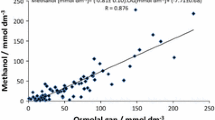Abstract
Introduction
Assays for ethylene glycol (EG) with a rapid turn-around time are not routinely available. Clinicians must rely on historical features and readily available clinical tests, combined with clinical acumen, to guide the initial management of suspected EG poisoning. Hypocalcemia has been suggested as a clue supporting the diagnosis of EG poisoning in patients presenting with an unexplained high anion gap metabolic acidosis (HAGMA). A previous small study challenged this assumption.
Methods
This was a retrospective case series of one state’s poison control system of confirmed EG-poisoned patients between September 2017 and April 2021. The definition of EG poisoning was based on suspected EG ingestion and a serum EG concentration > 5 mg/dL. Patients who were suspected to have EG toxicity but did not have a confirmed EG concentration or the EG concentration was less than 5 mg/dL were excluded. Routine laboratory studies were recorded for all patients. Comparisons between serum calcium on presentation to presenting blood pH, bicarbonate, anion gap, and creatinine were assessed for correlation.
Results
There was no correlation between the presenting calcium and either pH or creatinine. There was a weak positive correlation between the initial serum calcium and anion gap, a weak negative correlation between the initial serum calcium and bicarbonate.
Conclusion
On hospital presentation, hypocalcemia was not associated with EG poisoning, even in patients with a HAGMA. A normal serum calcium on presentation does not exclude the diagnosis of EG poisoning.


Similar content being viewed by others
References
Wiener S. Toxic Alcohols. In: Nelson L, Howland MA, Lewin NA, Smith SW, Goldfrank LR, Hoffman RS, editors. Goldfrank’s toxicologic emergencies. Eleventh edition. ed. New York: McGraw-Hill Education; 2019. p. 1421–34.
Mégarbane BBS, Baud FJ. Methanol, ethylene glycol and other toxic alcohols. In: Shannon M, Borron SW, Burns MJ, Haddad LM, Winchester JF, editors. Clinical management of poisoning and drug overdose. 4th ed. Philadelphia: Saunders/Elsevier; 2007. p. 611–22.
Scalley RD, Ferguson DR, Piccaro JC, Smart ML, Archie TE. Treatment of ethylene glycol poisoning. Am Fam Physician. 2002;66(5):807–12.
Stasinskis R, Stasinska K, Mukans M, Graudins A, Liguts V, Lejnieks A. Changes in ionized calcium in ethylene glycol poisoning. Proc (Bayl Univ Med Cent). 2022;35(4):460–5.
Hodgman M, Marraffa JM, Wojcik S, Grant W. Serum calcium concentration in ethylene glycol poisoning. J Med Toxicol. 2017;13(2):153–7.
Sutter ME, Al-Khameess WA, Abramson JL, Morgan BW. Predictors of ethylene glycol ingestion cases called into a regional poison center. J Med Toxicol. 2012;8(2):130–4.
Solubility Product Constants. https://www.periodni.com/solubility_product_constants.html. accessed 29 Dec 2021.
Jacobsen D, Ovrebø S, Ostborg J, Sejersted OM. Glycolate causes the acidosis in ethylene glycol poisoning and is effectively removed by hemodialysis. Acta Med Scand. 1984;216(4):409–16.
Xiong Y, Kirkes L, Westfall T. Experimental determination of solubilities of di-calcium ethylenediaminetetraacetic acid hydrate [Ca2C10H12N2O8·7H2O(s)] in NaCl and MgCl2 solutions to high ionic strengths and its Pitzer model: applications to geological disposal of nuclear waste and other low temperature environments. Chem Geol 2017;454:15–24.
Popovici A, Geschickter CF, Reinovsky A, Rubin M. Experimental control of serum calcium levels in vivo. Proc Soc Exp Biol Med. 1950;74(2):415–7.
Sanderson PH, Marshall F 2nd, Wilson RE. Calcium and phosphorus homeostasis in the parathyroidectomized dog; evaluation by means of ethylenediamine tetraacetate and calcium tolerance tests. J Clin Invest. 1960;39(4):662–70.
Spencer H, Vankinscott V, Lewin I, Laszlo D. Removal of calcium in man by ethylenediamine tetra-acetic acid A metabolic study. J Clin Invest. 1952;31(12):1023–7.
Centers for Disease C, Prevention. Deaths associated with hypocalcemia from chelation therapy--Texas, Pennsylvania, and Oregon, 2003-2005. MMWR Morb Mortal Wkly Rep. 2006;55(8):204–7.
Leaf DE, Christov M. Dysregulated mineral metabolism in AKI. Semin Nephrol. 2019;39(1):41–56.
Stokes JB 3rd, Aueron F. Prevention of organ damage in massive ethylene glycol ingestion. JAMA. 1980;243(20):2065–6.
Pagana KD, Pagana TJ, Pagana TN. Mosby’s diagnostic and laboratory test reference. 15th edition. ed. St. ed. Louis: Mosby; 2021.
Vo KT, Wu AH, Smollin C, Benowitz NL. A falsely elevated ethylene glycol level using laboratory enzymatic assay. Abstracts from the 2016 American College of Medical Toxicology (ACMT) Annual Scientific Meeting. J Med Toxicol. 2016;12:10.
Funding
None.
Author information
Authors and Affiliations
Corresponding author
Ethics declarations
Conflict of Interest
None.
Additional information
Supervising Editor: Howard Greller, MD
Publisher’s Note
Springer Nature remains neutral with regard to jurisdictional claims in published maps and institutional affiliations.
Rights and permissions
Springer Nature or its licensor (e.g. a society or other partner) holds exclusive rights to this article under a publishing agreement with the author(s) or other rightsholder(s); author self-archiving of the accepted manuscript version of this article is solely governed by the terms of such publishing agreement and applicable law.
About this article
Cite this article
Hodgman, M.J., Marraffa, J.M., Wiener, B.G. et al. Assessing the Role of Initial Serum Calcium Concentration in Patients with Ethylene Glycol Poisoning. J. Med. Toxicol. 19, 368–373 (2023). https://doi.org/10.1007/s13181-023-00958-y
Received:
Revised:
Accepted:
Published:
Issue Date:
DOI: https://doi.org/10.1007/s13181-023-00958-y




